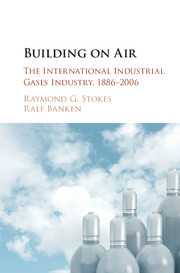Refine search
Actions for selected content:
13588 results in History of science and technology
Part II - Seeking equilibrium in an age of turbulence, 1914–1960
-
- Book:
- Building on Air
- Published online:
- 05 October 2015
- Print publication:
- 20 October 2015, pp 87-200
-
- Chapter
- Export citation
5 - Reinventing the industry starting in the 1950s
- from Part II - Seeking equilibrium in an age of turbulence, 1914–1960
-
- Book:
- Building on Air
- Published online:
- 05 October 2015
- Print publication:
- 20 October 2015, pp 169-200
-
- Chapter
- Export citation
Index
-
- Book:
- Building on Air
- Published online:
- 05 October 2015
- Print publication:
- 20 October 2015, pp 455-465
-
- Chapter
- Export citation
Introduction
-
- Book:
- Building on Air
- Published online:
- 05 October 2015
- Print publication:
- 20 October 2015, pp 1-14
-
- Chapter
- Export citation

Building on Air
- The International Industrial Gases Industry, 1886–2006
-
- Published online:
- 05 October 2015
- Print publication:
- 20 October 2015
6 - Revolutionary transformation continued
-
- Book:
- The Rise of Modern Science Explained
- Published online:
- 05 March 2016
- Print publication:
- 24 September 2015, pp 218-255
-
- Chapter
- Export citation
Timeline 1: pre-1600
-
- Book:
- The Rise of Modern Science Explained
- Published online:
- 05 March 2016
- Print publication:
- 24 September 2015, pp 279-279
-
- Chapter
- Export citation
Frontmatter
-
- Book:
- The Rise of Modern Science Explained
- Published online:
- 05 March 2016
- Print publication:
- 24 September 2015, pp i-iv
-
- Chapter
- Export citation
Epilogue: a look back and a look ahead
-
- Book:
- The Rise of Modern Science Explained
- Published online:
- 05 March 2016
- Print publication:
- 24 September 2015, pp 256-278
-
- Chapter
- Export citation
A note on the literature
-
- Book:
- The Rise of Modern Science Explained
- Published online:
- 05 March 2016
- Print publication:
- 24 September 2015, pp 282-286
-
- Chapter
- Export citation
Introduction: the Old World and the New
-
- Book:
- The Rise of Modern Science Explained
- Published online:
- 05 March 2016
- Print publication:
- 24 September 2015, pp 1-6
-
- Chapter
- Export citation
5 - Expansion, threefold
-
- Book:
- The Rise of Modern Science Explained
- Published online:
- 05 March 2016
- Print publication:
- 24 September 2015, pp 183-217
-
- Chapter
- Export citation
4 - A crisis surmounted
-
- Book:
- The Rise of Modern Science Explained
- Published online:
- 05 March 2016
- Print publication:
- 24 September 2015, pp 145-182
-
- Chapter
- Export citation
3 - Three revolutionary transformations
-
- Book:
- The Rise of Modern Science Explained
- Published online:
- 05 March 2016
- Print publication:
- 24 September 2015, pp 102-144
-
- Chapter
- Export citation
Timeline 2: 1600–1700
-
- Book:
- The Rise of Modern Science Explained
- Published online:
- 05 March 2016
- Print publication:
- 24 September 2015, pp 280-281
-
- Chapter
- Export citation
1 - To begin at the beginning: nature-knowledge in Greece and China
-
- Book:
- The Rise of Modern Science Explained
- Published online:
- 05 March 2016
- Print publication:
- 24 September 2015, pp 7-50
-
- Chapter
- Export citation
Provenance of quoted passages
-
- Book:
- The Rise of Modern Science Explained
- Published online:
- 05 March 2016
- Print publication:
- 24 September 2015, pp 287-293
-
- Chapter
- Export citation
2 - Islamic civilisation and medieval and Renaissance Europe
-
- Book:
- The Rise of Modern Science Explained
- Published online:
- 05 March 2016
- Print publication:
- 24 September 2015, pp 51-101
-
- Chapter
- Export citation
Contents
-
- Book:
- The Rise of Modern Science Explained
- Published online:
- 05 March 2016
- Print publication:
- 24 September 2015, pp v-vi
-
- Chapter
- Export citation
Index
-
- Book:
- The Rise of Modern Science Explained
- Published online:
- 05 March 2016
- Print publication:
- 24 September 2015, pp 294-296
-
- Chapter
- Export citation
